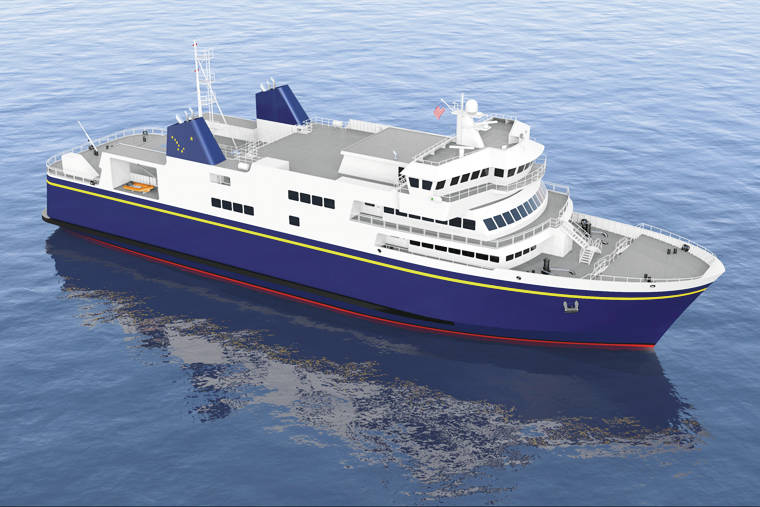As Alaska struggles to solve a multibillion-dollar annual deficit, it seems like a distant dream: A state, flush with cash, spending $120 million to build two ships without a dime of federal help.
On Thursday, the state of Alaska and Vigor Maritime confirmed that one of the goals of the Alaska-class ferry program has failed.
At least one module of the under-construction ferry Hubbard will be built in Washington state instead of Alaska.
“It’s disappointing,” said Robert Venables, chairman of Alaska’s Marine Transportation Advisory Board and head of Southeast Conference, a coalition of municipal governments and organizations.
“In our most perfect world, we do want to have the ability to construct ferries here in the region and the state. I think we’re lightyears ahead of where we were,” he said.
Under the Alaska-class ferry program, the state forfeited more than $100 million in potential federal aid in order to build two 280-foot ships entirely within Alaska. The federal government typically pays almost 90 percent of the cost of infrastructure projects, but in this case, it would have required the state to take bids from Outside shipyards. With oil prices high and the state’s coffers overfull, then-Gov. Sean Parnell turned down the federal aid, even returning more than $1 million that had already been spent, to build the ships here. Ketchikan’s shipyard, then known as Alaska Ship and Drydock Inc., won the state bid.
As originally designed in the early 2000s, the Alaska-class ferry program was to build a single 350-foot oceangoing ship with crew quarters. It was to serve as a model for a smaller, more efficient design of ship to supplement and possibly replace the state’s aging mainline ferries. At the time, Parnell called it “the next generation of ferries to serve communities across Alaska.”
Within a year, he changed the plan. In 2012, he scrapped the design for the 350-foot ship in favor of two shorter “day boats” without crew quarters. The day boats, subsequently named the Tazlina and Hubbard by Gov. Bill Walker, were intended to travel between Skagway and Haines and the end of a road extending north from Juneau.
The road was canceled by Walker, but the ferries never were. The Tazlina, nearly complete, was built entirely in Ketchikan, but Vigor faces an October deadline to deliver both ships to the state.
“We discovered that we won’t be able to make the contract delivery date of October of this year,” said Doug Ward, who manages the Ketchikan shipyard.
Ward said a number of factors contributed to the failed goal.
“It’s related to the workforce. It’s related to just the size of the vessel and the real estate we have available to us,” he said. “In general, what we need now are journey-level workers, and it’s hard to find journey-level shipbuilders in Alaska.”
Ward said he knows Alaskans will be disappointed.
“We understand the governor’s desire to have it all built in Ketchikan. That was our plan. That has always been our plan,” he said.
According to the original plan of construction, the Tazlina and Hubbard were to be built of 23 different modules each. The modules, constructed in Ketchikan, were to be welded together in Ketchikan shipyard’s enormous assembly hall like Legos snapped together.
Module No. 14, the engine room, will be built in Vancouver, Ward said, and module No. 19 (steering gear) and module No. 20 (the stern) may also be built in Washington, he said. An exact plan is still being worked out. The modules would be shipped north for final assembly.
In addition, Ward said the shipyard is hiring 35 new workers, bringing the total workforce to 110. Another 110 work on overhauling existing ships, he said. (Several Alaska Marine Highway system ferries are undergoing maintenance during the winter.)
Marc Luiken, commissioner of the Alaska Department of Transportation and Public Facilities, said Gov. Bill Walker “really preferred to have 100 percent of the work done in Alaska,” but “ultimately, really, it’s Vigor’s decision.”
The contract between the state and Vigor allows up to 13 percent of a ship to be built Outside.
Though both ferries won’t be built entirely in Alaska, Venables and Ward each said the long-term goal remains on track.
“The real goal, the endgame for the investment there is to build a marine manufacturing base that will go on into the future. To my knowledge, that is still on track,” Venables said.
• Contact reporter James Brooks at james.k.brooks@juneauempire.com or call 523-2258.

